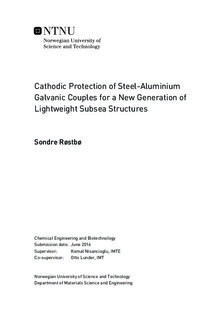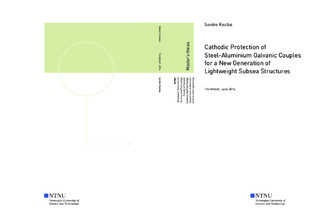| dc.description.abstract | A new generation of lightweight subsea structures is planned for application in oil and gas production. Due to increasing weight of subsea installations, the use of aluminium as a structural material is of continuous interest. A problem is that galvanic corrosion will occur since not all steel components can be replaced by aluminium, and the two metals need to be isolated from each other. Another solution is to protect both metals from corrosion by a common cathodic protection system.
The purpose of this thesis was to show by laboratory research if it is possible to protect steel-aluminium galvanic couples against corrosion by cathodic protection. Samples of X65 carbon steel, 6005 aluminium and an AlZnIn sacrificial anode were studied by galvanic corrosion testing, open circuit testing and potential sweep. Steel and aluminium samples were connected in a simulated crevice of 100 μm to study the effect of galvanic crevice corrosion. Weight loss measurements were performed to determine corrosion rates, and the sample surfaces were characterized by SEM and EDS. Electrochemical testing was performed in both artificial seawater and a 3.5% NaCl solution.
It was found that cathodic protection of steel-aluminium galvanic couples is possible in the absence of crevice corrosion. In a three-metal coupling, the sacrificial anode supplied cathodic current to both steel and aluminium. The reduction rate on steel was between 1 and 2 orders of magnitude larger than that on aluminium. The lower current density on aluminium was due to the fact that reduction only occurs on Fe-rich intermetallic particles in the Al matrix. During cathodic polarization of aluminium, an alkaline etching process caused detachment of these cathodic particles for surface pH sufficiently high. Calcareous deposits precipitated on steel under cathodic protection, but had little or no effect on the current density at a potential controlled by AlZnIn.
Cathodic protection applied to a galvanic crevice between steel and aluminium gave a high local corrosion rate of aluminium near the crevice mouth. The steel was completely protected. The local corrosion rate of aluminium was sufficiently high to give anodic net current despite being connected to a sacrificial anode. The phenomena was an initial stage related to a potential and current distribution across the crevice. A very high local reduction rate on steel caused a high pH and thus corrosion of aluminium. The reduction rate on steel decreased as a function of time along with the corrosion rate of aluminium. | |

